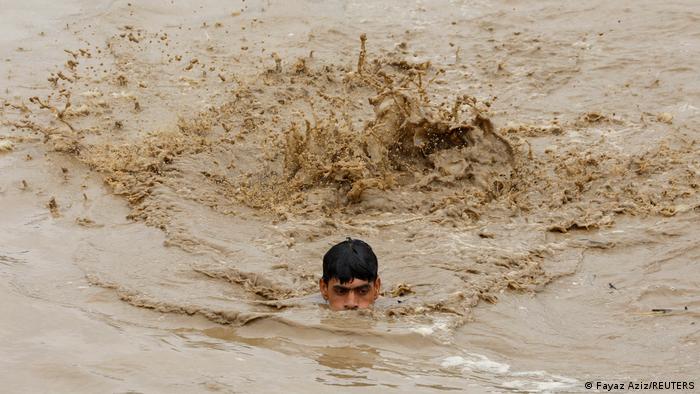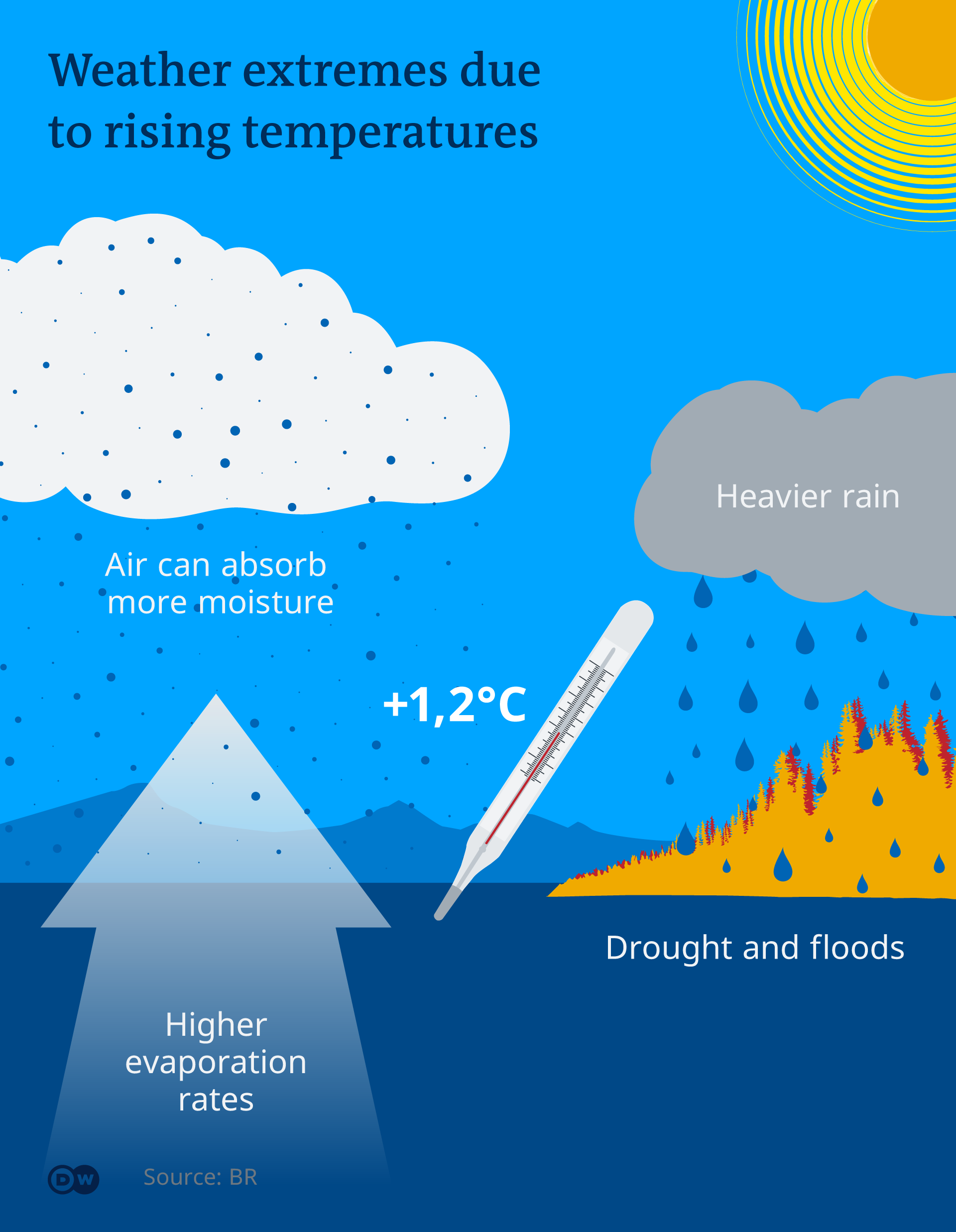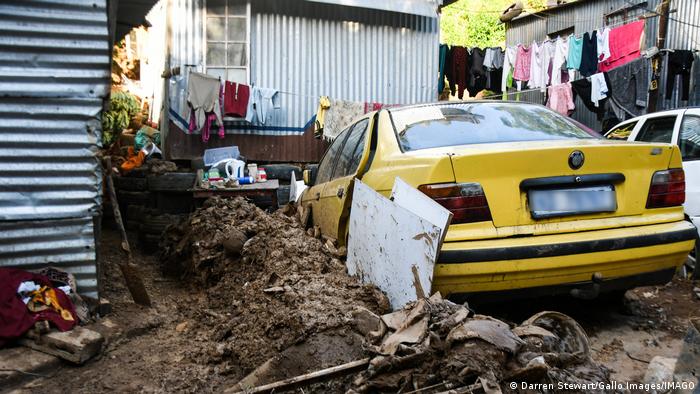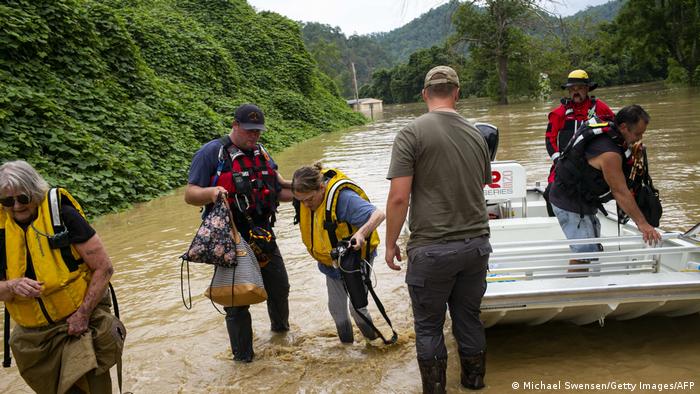Attribution scientists are modeling floods, droughts and wildfires in real time to determine how big a part global heating plays in each event. DW takes a closer look.

Torrential rains have turned parts of Pakistan into 'small oceans'
After scorching heat waves withered crops and dried up mighty rivers in the Northern Hemisphere, catastrophic super flooding in Pakistan has so far killed more than a 1,000 people, displacing millions more.
Pakistan's climate change minister, Sherry Rehman, told DW much of the flood area she surveyed from helicopter looked like a "small ocean" because of the relentless rain that followed soaring temperatures earlier in the year and a season of forest fires.
"It is a climate catastrophe, I'm very clear," said Rehman.
That heating the planet by burning fossil fuels is broadly making extreme weather more frequent and intense is well established. Scientists have been sounding the alarm bells on that for years.
But just how big a factor is climate change in deadly flooding like that in Pakistan or in the heat waves that dried up Europe this summer
Establishing a direct causal link between rising global average temperature and a single storm, for instance, is difficult and an evolving science.
"Extreme weather has always existed and will always exist," said Sjoukje Philip, a climate researcher at the Royal Netherlands Meteorological Institute (KNMI). "But climate change might, however, have an impact on the probability or extremity of the extreme weather events."
Determining climate change's contribution is exactly what Philip, who works with an international research team at the World Weather Attribution initiative (WWA), is trying to do by conducting real-time attribution analysis of global weather events as they occur.
Does global warming cause flooding and heat waves?
Weather catastrophes are never down to just one cause. They result from natural factors, as well as human-made ones. For instance, large-scale deforestation and paving over green areas that would usually absorb heavy rainfall with concrete and tarmac can worsen flooding.
Climate change is a human factor too, of course, but is never the sole trigger of a weather catastrophe. Its influence depends on the weather phenomenon in question and is weighted differently for each event, said German climatologist Friederike Otto from Imperial College in London and a founder of the WWA research team.

Climate change plays a big role for some events, said Otto, "but for most others like heavy rainfall or droughts, it is quite often a relatively small factor compared to others."
So while global heating alone cannot cause heavy rain, it can facilitate prime conditions and increase the amount of precipitation.
"A warmer atmosphere can hold more moisture, which can result in heavier rainfall," said Philip. But where and when that falls depends on a variety of factors, she added.
The link between temperature extremes and global heating is much more direct, said Philip. Swings in temperature are not necessarily more extreme but as global average temperatures rise, heat waves have grown hotter and cold spells milder.
Without global heating, recent record temperatures of 40 degrees Celsius (104 Fahrenheit) in the United Kingdom would have been virtually impossible, as would the North American heat wave of 2021, according to WWA analyses. And climate change made deadly early heat waves in India and Pakistan this year 30 times more likely.
"With heat waves climate change is really a game changer," said Friederike Otto.
Does climate change have the same impact everywhere?
Climate change impacts also differ from region to region, said Philip. "So even for similar types of extreme weather, it can still be different for different regions."
Take the Ahr Valley flood in Germany and Belgium in July 2021 compared to flooding in the South African province of KwaZulu-Natal in April 2022 as an example. At least 435 people died in the latter flood and thousands were made homeless. In the Ahr Valley, heavy rainfalls triggered flooding that killed more than 220 people.
The heavy rainfall in the Ahr Valley would have been a once in 500-year event around the start of the 20th century. That means we could have reckoned with such an extreme event every 500 years in an area of a similar size between the Alps and the North Sea under global average temperatures seen in the year 1900, according to a WWA analysis.

Flood damage in KwaZulu-Natal. Climate change's influence on extreme weather depends on multiple factors
Global heating made the event 1.2 to 9 times more likely, so in today's climate, we can expect such a flood every 56 to 400 years. At the same time, the rainfall was likely 3 to 19% stronger than it would've been 120 years ago, said the research group.
In KwaZulu-Natal, the researchers found climate change had made torrential rains that washed away entire settlements between 4 and 8% stronger. The probability, meanwhile, had doubled since 1900.
So, the uncertainties in weather attribution vary greatly depending on location. Climate scientists can determine the influence of warming more precisely in bigger regions. The area flooded in South Africa was many times larger than the affected valleys in Belgium and Germany. But it's clear that the influence of global warming on heavy rainfall in South Africa is in all probability smaller than in Central Europe.
Predicting future weather disasters
Potential disasters in the distant future cannot be predicted with existing models — the weather is too chaotic for that. Serious weather forecasts are still only possible a few days in advance.
But what weather attribution models can "calculate very well is the frequency of certain weather patterns," said Otto. And according to WWA findings, as we continue to burn fossil fuels causing global average temperatures to rise, weather patterns that can trigger floods, droughts and other extremes become more likely.
CLIMATE CHANGE: FLOODING, DROUGHT, FIRE AND HEAT WAVES AROUND THE WORLDHeavy rains devastate communities in Kentucky, USAHeavy rain has pummeled mountain communities in the US state of Kentucky. Water rushed down hillsides, swallowing towns, washing away homes and trapping hundreds of people. At least 30 people have been killed. US Vice President Kamala Harris said the flooding showed the urgency of crisis and announced $1 billion in grants to help states prepare for weather extremes worsened by climate change.
This article was originally published in German.

No comments:
Post a Comment